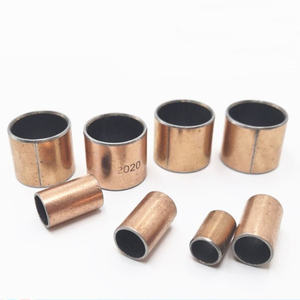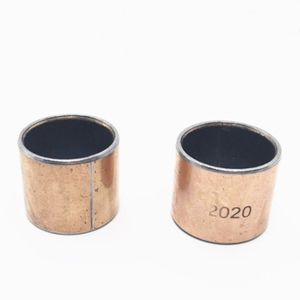(20865 products available)






























































































































































Oiles bushing is a product, and it typifies an oil-embedded bushing that is used anywhere from the industrial to the commercial to the automotive. Furthermore, it is manufactured with great bearing material that contains an oil reservoir (embedded in it), and as the oil seeps out slowly, it provides lubrication to the surface of the shaft, helping to reduce friction, wear, and tear.
This product comes in various types, and each serves a specific function, as listed below.
Spherical Oiles Bushings
Spherical Oiles bushing is engineered with a bearing surface formed into a spherical shape (convex surface) to provide smooth rotation in any given direction. They are ideal for applications where misalignment is possible, and they compensate for shaft deflection or misalignment during operation. Industries that require such applications as construction equipment, robotics, and mining machinery often use them.
Cylindrical Oiles Bushings
Cylindrical Oiles bushings are used for cylindrical-shaped shafts and generally provide linear motion and support. They are great for offering wear resistance when properly lubricated with the oil-embedded feature. Common applications include the following: sliding shafts in machine tools, automotive parts, and industrial equipment.
Slewing Oiles Bushings
Slewing Oiles bushings are typically designed for applications that require the following: rotation around an axis. They are commonly used in the equipment used in several industries, including mining, offshore, and construction. Some examples of these are excavators, cranes, and trucks.
Flanged Oiles Bushings
Flanged Oiles bushings are manufactured with a flange or collar on one end and thus serve to facilitate easy installation and location in a housing or mating component. Their feature is especially useful in applications where axial positioning and misalignment correction are required. Typical applications include automotive components, steering systems, and Industrial machinery.
Thin-walled Oiles Bushings
Thin-walled Oiles bushings are low-profile and less bulky for applications where space is a constraint, but you still need good lubrication and wear resistance. They can be used in areas where the shaft diameter is small, or the design requires light weight. For example, one can find them being used in electronic devices, small motors, and precision engineering equipment.
The materials used in constructing various Oiles bushings directly impact their durability and application. Some of the items that feature in their construction include the following.
Bushing Alloy
The bushing alloy refers to the specific kind of metal or combination of other metals that form the base or substrate for an Oiles bushing. Typically, they are metals such as bronze (which is reinforced with some form of material for strength and wear resistance) or patented PTFE (which is used due to its low friction and corrosion resistance). These materials are chosen because of their strength, resistance to wear, and their ability to withstand high temperatures and load-carrying capacity, making them suitable for rugged or industrial environments.
Pore Structure
Pores are the minute holes or voids intentionally created within the bushing material's surface to hold or carry lubricating oil. The size, distribution, and shape of these structures affect how much oil can be stored in the bushing for lubrication and how well the bushing reduces friction. The optimal lubrication leads to lower wear on both the bushing and the shaft, resulting in longer life.
Anti-adhesive Composition
The anti-adhesive composition refers to the particular materials or additives incorporated into the bushing to reduce adhesion to other surfaces. This feature is especially important in applications where the bushing may come into contact with different materials, as it lowers the risk of material transfer or "welding" between the two surfaces. Normally, PTFE is added to the bushing alloy to enhance anti-adhesive properties and reduce friction further, making it ideal for applications where some form of sectioning between the bushing and other surfaces is necessary.
Lubricant
The lubricant in this case is the oil that saturates the bushing's pores during production and then gets released gradually to help in lubrication through operation. Commonly, these oils are specially formulated for longevity, reducing friction, and preventing corrosion. They are also likely to be integrated with additives that will enhance performance features, such as anti-wear and rust inhibitors. The combination of the pore structure and the type of oil used ensures that the bushing needs minimal maintenance while providing effective lubrication over its life span.
Maximizing Bushing Life
Oiles bushings are constructed to provide optimum resistance to wear, a feature that significantly increases the lifespan of both the bushing and any equipment it may be fitted into. By reducing wear on moving parts, Oiles bushings help to extend the overall life of machines and thus reduce the need for frequent repairs or replacements.
Facing Indirect Costs
Indirect costs are, for instance, administrative costs, customer service costs, utility costs, etc. because they are all a function of idle equipment in a production set. Oiles bushings reduce equipment downtime by providing superior lubrication and wear resistance in constant motion, as mentioned. This equates to increased productivity and lower costs associated with the disruption of operations or the need for unplanned maintenance.
Increased Equipment Efficiency
Some applications of Oiles bushings include, say, bushings within Industrial machinery, components in construction equipment, or parts of mining rigs. They also enhance the effectiveness of equipment by reducing friction and enabling smoother operations. Hence, less energy is required to perform a given task and, therefore, translating into lower operating costs.
Lower Energy Consumption
The smooth motion provided by Oiles bushings reduces friction between moving parts. This requires less energy to operate the equipment, be it electric or non-electric energy. Over time, energy savings can be substantial, especially in an industrial environment where large machinery is in constant use.
Reduced Downtime
Downtime in equipment refers to the total time that the equipment is not operational. With Oiles bushings, the need for frequent maintenance and replacement is reduced, allowing businesses to avoid the costs and disruptions associated with extended periods of equipment downtime. This keeps operations running smoothly, maximizing productivity and commercial output.
Preventing Equipment Failure
The superior wear resistance of Oiles bushings helps to prevent the possible damage that would occur to the shaft or to the machinery that uses the bushing. By eliminating this problem, Oiles bushings help to avoid the costs of replacing or repairing major pieces of equipment and the associated disruption to business operations.
Extending Maintenance Intervals
Oiles bushings require less frequent lubrication and maintenance than standard bushings, which is an all-around good thing. This, of course, means labor and resources can be diverted away from maintenance tasks and towards more productive activities.
Bushing Material
Various bushing materials have their individual wear-resistance properties, load-bearing capacities, and operating temperature ranges. For instance, bronze is good for heavy loads, while PTFE is ideal for chemically sensitive or low-friction environments. The specific operating conditions will determine the material that will be most appropriate for that application.
Environmental Factors
External environmental factors such as humidity, temperature, and exposure to chemicals or contaminants are considered. Humidity will, of course, affect the bushing lifespan, while the said bushing may be, for example, dust or moisture-proof. Certain materials provide better resistance to chemical corrosion or oxidation than others. For example, Oiles's PTFE bushings are ideal for chemically aggressive environments.
Maintenance Requirements
Different bushings will, of course, come with different maintenance requirements, i.e., some will require frequent lubrication or checks, while others are less or nearly self-lubricating. In the case of Oiles bushings that are designed for use in applications that are hard to reach or where maintenance is not easily feasible, then go for a low-maintenance lubrication bushing.
Shaft Compatibility
The shaft compatibility is simply the question of ensuring that the bushing material and inner diameter are a good fit for the shaft of the equipment. The bushings should reduce clearance to a minimum while allowing for thermal expansion. At the same time, the outer diameter should match the housing into which it is fitted.
Load Conditions
Consider the load conditions for the application: are they high or low? Are they dynamic or static? The dynamic and static loads, speed, and type (intermittent or continuous) determine the type of bushing suitable for the given conditions. For high-load applications, Oiles bushings are meant for high-load and wear-resilient resistance, like metal-embedded polymer PTFE bushings.
Friction and Wear Resistance
This is the degree to which a material resists wear over time in conditions of friction. Low friction is ideal because it reduces wear on both the bushing and the shaft, thus extending the lifespan of the equipment. Oiles bushings make use of such materials that provide low friction contact with high resistance to wear - for instance, the combination of bronze or brass with polymer embedding.
Nutmeg Oiles bushings are distinctive throughout the industry because they come pre-lubricated with oil that seeps through the embedded material. While some Oiles bushings may need periodic lubrication, the key advantage is that they provide extended lubrication with minimal maintenance.
Oiles bushings are designed for durability in various conditions, including resistance to corrosion. The materials and additives in some Oiles bushings, like the alloy-embedded polymers, have a degree of chemical and moisture resistance to protect against rust and other forms of corrosion. This makes them ideal for use in demanding and harsh environments.
Oiles bushings are specifically designed with materials that maintain their structural integrity and lubricating properties even at elevated temperatures. For instance, bronze or brass with polymer embedded materials offers high friction and wear resistance, creating a bushing ideal for high-temperature and high load applications such as mining and construction. Oiles has special high-temperature PTFE bushing versions to cope with extreme thermal environments in the oil and gas industry.
Oiles bushings form an ideal solution for supporting shafts in brushless and small motors in electronic gadgets. They reduce friction while being non-magnetic, thus protecting the motor's magnetic fields for proper functioning. In other words, various applications with limited space and current solidity requirement place themselves within.